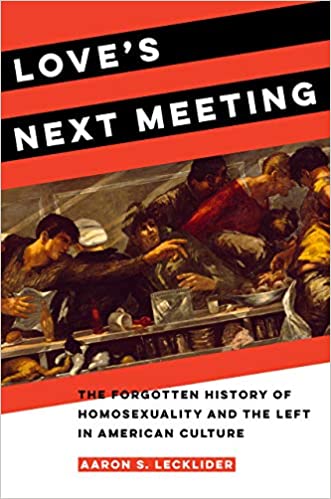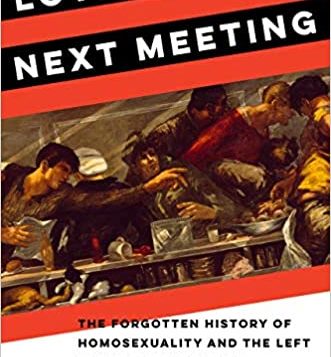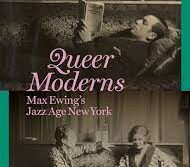 LOVE’S NEXT MEETING
LOVE’S NEXT MEETING
The Forgotten History of Homosexuality and the Left in American Culture
by Aaron S. Lecklider
Univ. of California. 354 pages, $29.95
THOSE OF US with both homosexual and leftist tendencies have always been a little squeamish about examining the relationship between the two, flinching when we remember the Communist party line on homosexuality as bourgeois decadence. But in Love’s Next Meeting, Aaron Lecklider, associate professor of American Studies at U. Mass–Boston, tackles this aspect of American history and untangles a complicated story through sometimes oblique but always illuminating analysis.
In the author’s words, the book revisits “a relationship often characterized as a series of misgivings, betrayals, dismal disappointments, and interpretive dead ends.” It explores this “counterhistory” by aligning political dissidence and sexual dissidence: “The act of joining a revolutionary party seeking to overthrow the government of the United States pushed against the boundaries of respectability, morality, and decency that governed American life. … Homosexuality was associated with a similar refusal to submit to American norms, creating discursive overlap between sexual dissidents and leftists that blurred the line separating one group from the other.”
There are two things to note at the start. First, as the use of “discursive” suggests, this is an academic book, with forty pages of endnotes. It uses the language of “agency,” “intersection,” and especially “space.” But by now this language has become familiar to general readers beyond the academy, and here it never becomes obscure. Also, Lecklider has done deep archival dives. Much of the source material consists of unpublished stories or early drafts of works, of personal letters and diaries, material not only not meant for public viewing but often actively avoiding it. Second, the story he tells will disappoint anyone who wants a triumphalist vision of gays and Communists joyously embracing. He hasn’t uncovered any rainbow stripes in the red flag. He finds “space” for homosexuality on the Left where others might see only closets, though it sometimes takes highly nuanced poking and prodding to open up that space.
The book begins engagingly with “the lived experiences of sexual dissidents on the Left” to show how individuals negotiated their two identities. For example, the poet and critic John Malcolm Brinnin wrote to his lover that a trip to Detroit had been wonderful: “first, oh so terribly first, I have discovered how unbelievably much I love you; second, I have sung with raised fist the Internationale among nine thousand people.” Comments Lecklider: “Where one might expect a bifurcation of Brinnin’s political and sexual identities, instead Brinnin reveals a deeply affective resonance that unites along axes of longing and belonging.”
The author then considers “how leftists conceived sexual politics more generally.” V. F. Calverton wrote in New Masses that “the radical who is enthusiastic about revolution in economics but timid about revolution in sexual life is narrow-minded and superficial.” This expanded tolerance on the Left for nonstandard heterosexual behavior “created a foundation upon which leftists constructed a politics of homosexuality.” Finding that foundation, however, often requires subtle and creative analysis. For example, the 1940 memoir of Benjamin Gitlow, who styled himself “America’s first Communist prisoner in Sing-Sing,” goes into great detail on the variety of “degenerates” in the prison—but, as Lecklider says, with “a tone of sociological objectivity that stopped short of the kind of condemnation found in other leftist accounts,” thereby showing “how leftists alternately replicated and pushed against the politics of deviance on the Left.” This push and pull runs through much of the book, as he finds space for some limited gay affirmation in what initially seems unpromising material.
Given the centrality of labor to the Left, the chapter on labor and homosexuality is particularly illuminating. The Marine Cooks and Stewards Association, which unionized workers on ocean liners, was called by its own members “Marine Cocksuckers and Fruits” and was, a member later recalled, “a third red, a third black, and a third queer.” As a specific form of work, male hustling attracted ambivalent attention on the Left: “On its most basic level, male hustling seemed to represent the purest distillation of capitalism’s most exploitative excesses.” Lecklider describes The Shadow Before by William Rollins Jr., a 1934 proletarian novel about a strike. Olsen, “a heroic gay mill worker and unapologetic femme,” is inspired to radicalism by his crush on a straight fellow worker: “Olson’s queer desire is not sacrificed to his politics. His politics are, rather, a natural outgrowth of his queerness.”
While much of the available material centers on men, Lecklider does devote a chapter to women, starting with Betty Millard, a New Masses editor, who, after dinner with a male comrade, noted in her diary that “Socialism & sex is what I want all right. I just didn’t happen to explain to him which sex.” The chapter examines theorizing on the gender issue, examples of leftist lesbian couples, and lesbianism in proletarian fiction.
One chapter consists of an extended analysis of two proletarian novels by writers of color. Knock on Any Door, a 1947 novel by Willard Mosley—described in his FBI file as a “Negro writer with Leftist and homosexual tendencies”—centers on Nick Romano in the slums of Chicago, where he engages in robbing gays and hustling but also develops a friendship with Owen, a gay man. Mosley writes suggestively: “Owen was someone who understood Nick because Owen, in his way, lived outside the law, too.” In the unpublished draft, however, the relationship is more explicitly sexual than the publisher would permit. The second work, H. T. Tsiang’s The Hanging on Union Square, self-published in 1935, is what Lecklider calls “proletarian burlesque,” tracing the evolution of Mr. Nut into a Communist revolutionary, aided by the butch organizer Miss Stubborn.
The final two chapters cover “two seismic historical shifts.” The first, during World War II, concerns antifascism and the Popular Front. As an example, Lecklider shows how the gay professor Newton Arvin “harnessed the democratic energy of the Popular Front to argue for the interwoven radicalism of Whitman’s political and sexual themes.” The second shift, the Cold War, saw Communism and homosexuality as twinned menaces, and the emerging homophile movement sought respectability by purging leftists like Harry Hay. ONE magazine wrote that anyone trying to be Communist and homosexual is “attempting to reconcile the irreconcilable contradictions in their thinking.” Lecklider does show how gay leftists like James Baldwin and Lorraine Hansberry pushed back against this disavowal of homosexuality on the Left.
The title of the book comes from a poem by John Malcolm Brinnin that asks how “the single heart … moves/ Through savage times and science toward the joy/ Of love’s next meeting in a threatened space?” The lines capture the book’s essence, which finds “space” for gay leftists, however threatened, however tenuous, in the “savage times” of America’s 20th-century engagement with Communism. Through his diligent search for evidence of gay leftists and his close analysis of it, Lecklider has clarified our understanding of a complicated subject.
Michael Schwartz is an associate editor of this magazine.





